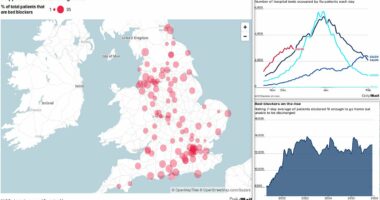Share this @internewscast.com
Nearly 1 in 10 new COVID-19 cases in the U.S. are from the BA.2.86 variant, the Centers for Disease Control and Prevention estimated Monday, nearly triple what the agency estimated the highly mutated variant’s prevalence was two weeks ago.
Among the handful of regions with enough specimens reported from testing laboratories, BA.2.86’s prevalence is largest in the Northeast: 13.1% of cases in the New York and New Jersey region are blamed on the strain.
Monday’s figures mark the first time BA.2.86’s prevalence has surged enough to be listed as a standalone variant on the CDC’s estimates. Scientists first warned of the highly mutated strain’s discovery over the summer.
Before this point, officials have said the vast majority of new COVID-19 cases have been blamed on the XBB variant and a crowd of XBB’s closely related descendants. Those include the HV.1 and EG.5 variants that are currently predominant nationwide.
The CDC’s estimates carry wide margins of error around BA.2.86’s prevalence. As little as 4.8% or as much as 15.2% of circulating SARS-CoV-2 could be from BA.2.86, the agency says.
However, this latest estimate – 8.8% through Nov. 25 – is virtually triple what it was on Nov. 11, when 3.0% of new cases were estimated to be BA.2.86. The CDC typically publishes its variant estimates every other Friday, but had delayed last week’s release until after the Thanksgiving holiday weekend.
The World Health Organization also recently stepped up its classification of BA.2.86 and its descendants to a “variant of interest” after a rise in cases from the strain.
Early data on BA.2.86 suggests it does not appear to lead to worse or different symptoms than previous strains, the World Health Organization said in its Nov. 21 risk evaluation, but noted a “substantial rise” in recent BA.2.86 reports.
It comes as the CDC has begun to track a renewed increase in indicators tracking COVID-19’s spread across the U.S. headed into the winter.
After weeks of largely slowing or flat trends, the CDC said this month that figures like emergency department visits had begun to increase nationwide from COVID-19. Virtually all regions of the country are now seeing at least slight increases.
Read Related Also: Unlock Radiant Skin: A Guide to Boosting Skin Cell Turnover Naturally
Some of the highest increases are in the Midwestern region covering Illinois, Indiana, Michigan, Minnesota, Ohio and Wisconsin, where trends are nearing levels not seen since early January.
Is the JN.1 variant to blame?
Since August, BA.2.86’s broad array of mutations did not appear to be enough for the strain to gain a foothold over XBB and its descendants. Months of the highly mutated variant’s spread only resulted in a small share of cases throughout the world.
But scientists in recent months have been studying a steep increase in a BA.2.86 descendant called JN.1, which quickly rose to become the fastest-growing subvariant worldwide.
Many cases have been reported in Europe, which has seen increasing cases from BA.2.86 and its descendants. The strain’s prevalence is as high as 22.7% in Spain.
Data from recent weeks tallied from the GISAID virus database suggests as much as a third of COVID-19 variants reported from labs in the U.S. have been of JN.1.
It is unclear what proportion JN.1 makes up of the CDC’s BA.2.86 estimate.
A spokesperson for the agency did not immediately respond to a request for comment.
Last month, the CDC said it expected COVID-19 tests and treatment would remain effective against JN.1, which is closely related to BA.2.86 aside from a single change to its spike protein that early research suggests is enabling it to spread faster.
This season’s vaccines are also expected to work against JN.1 similar to what was estimated for its BA.2.86 parent, the agency said.












